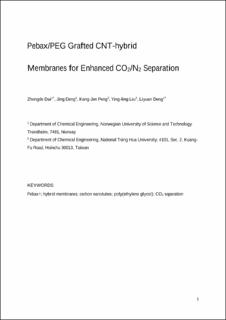| dc.contributor.author | Dai, Zhongde | |
| dc.contributor.author | Deng, Jing | |
| dc.contributor.author | Peng, Kang-Jen | |
| dc.contributor.author | Liu, Ying-Ling | |
| dc.contributor.author | Deng, Liyuan | |
| dc.date.accessioned | 2020-05-18T07:55:11Z | |
| dc.date.available | 2020-05-18T07:55:11Z | |
| dc.date.created | 2019-07-21T15:12:17Z | |
| dc.date.issued | 2019 | |
| dc.identifier.citation | Industrial & Engineering Chemistry Research. 2019, 58 (27), 12226-12234. | en_US |
| dc.identifier.issn | 0888-5885 | |
| dc.identifier.uri | https://hdl.handle.net/11250/2654718 | |
| dc.description.abstract | In the present study, poly(ethylene glycol) (PEG) functionalized carbon nanotubes (CNT-PEG) were used as nanoadditives to fabricate hybrid membranes for enhanced CO2 separation in Pebax 1657 matrix. The resultant membranes were characterized using various techniques. It is found that grafting PEG onto CNT fibers greatly improves the CNT dispersion. No noticeable aggregation can be found in the hybrid membranes with CNT-PEG content of up to 20 wt %. X-ray diffraction results denote that the CNT-PEG in the Pebax matrix increases the amorphous phase content, which is beneficial for CO2 permeation. Gas permeation properties were investigated using mixed gas permeation tests at different relative humidity conditions. It is found that CO2 permeability first increases and then decreases with increasing CNT-PEG content at the dry state. The water vapor in the gas stream further improves the CO2 permeability. At 100% relative humidity, CO2 permeability of 369.1 barrer with CO2/N2 selectivity of 110.8 was obtained for a hybrid membrane containing 3 wt % CNT-PEG, which overcomes the Robeson upper bound. The combination of high permeability and selectivity makes the Pebax/CNT-PEG hybrid membranes promising for industrial CO2 separation applications. | en_US |
| dc.language.iso | eng | en_US |
| dc.publisher | American Chemical Society | en_US |
| dc.title | Pebax/PEG Grafted CNT Hybrid Membranes for Enhanced CO2/N2 Separation | en_US |
| dc.type | Peer reviewed | en_US |
| dc.type | Journal article | en_US |
| dc.description.version | acceptedVersion | en_US |
| dc.source.pagenumber | 12226-12234 | en_US |
| dc.source.volume | 58 | en_US |
| dc.source.journal | Industrial & Engineering Chemistry Research | en_US |
| dc.source.issue | 27 | en_US |
| dc.identifier.doi | https://doi.org/10.1021/acs.iecr.9b01466 | |
| dc.identifier.cristin | 1712216 | |
| dc.description.localcode | Locked until 18.6.2020 due to copyright restrictions. This document is the Accepted Manuscript version of a Published Work that appeared in final form in [JournalTitle], copyright © American Chemical Society after peer review and technical editing by the publisher. To access the final edited and published work see https://doi.org/10.1021/acs.iecr.9b01466 | en_US |
| cristin.unitcode | 194,66,30,0 | |
| cristin.unitname | Institutt for kjemisk prosessteknologi | |
| cristin.ispublished | true | |
| cristin.fulltext | preprint | |
| cristin.qualitycode | 2 | |
